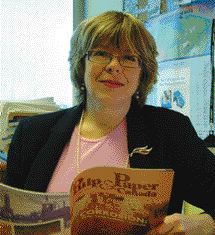
What a difference some good news makes!
What a difference some good news makes!
Although we briefly mentioned the opening of AV Nackawic in the last issue, there was really no time to turn around after my visit to the New Brunswick mill and still get a complete story with details published in our last issue. An event of this significance needed a bit more commitment to do it justice and so we hope that you will appreciate the information, gathered with the help of Kelvin Ryan, the organizational development specialist at AV Nackawic. Read the good news on page 14.
One of the interesting factors in this case was the example of diversification of products that some mills are undertaking. The hope is that this expansion of scope will alleviate the effects of the current economy and market situation. In a quote from Frank Dottori, he states that this was instrumental in Tembec’s decision to invest in AV Nackawic since it moved “away from the vagaries of the hardwood pulp business.”
In June, we focused on the intense activity generated by the biorefining concept and in this issue, AV Nackawic is set to convert to dissolving pulp for the production of rayon. In our Pulp & Paper People Poll this month, we changed our format from the usual multiple answer configuration to ask our readers what they suggested could be additional or alternative products from our mills. Take time to answer the poll on our website at www.pulpandpapercanada.com
Entertaining history
From the supplier side comes news of another major investment in our industry.
To the sounds and sights of speeches, singing, dancing and Chinese acrobats, the new Voith Paper Technology Centre (PTC) was inaugurated in Heidenheim, Germany, earlier this summer. It was a really spectacular affair which lasted for several days with thousands of guests on site, including politicians, customers, a multitude of employees and townspeople and Voith officials, as well as a group of international journalists (including yours truly). Highlights from the history of papermaking were re-enacted, culminating in the opening ceremonies for the newly built, 75-metre long experimental paper machine, designed for speeds of up to 3000 m/min. More about the PTC on page 32.
Improving the prospects
Back in Canada, many companies have either limited or eliminated their research and development departments. Thank goodness, Paprican still has dedicated member companies who allot their investment to this non-profit research organization in order to enrich the fund of knowledge in the industry. PPC has featured several articles about the services available there so that Canadian mills can continue to look forward to improving their production. See page 18 for the latest in a long-line of state-of-the-art equipment fine-tuned by Paprican research teams. The development of the Web and Roll Centre is one of the latest steps taken in order to offer a new roll testing facility to help analyze roll tension and structure, evaluate the quality of webs and paper rolls and solve problems that mills may have in these areas.
Three Amigos
You will notice soon, within the pages of our magazine, an expanded field of articles from related concerns in the forestry industry. It is a natural development, following our interest in the activities of Paprican which has taken the first steps to team with FERIC and Forintek to form a single research institute for the forest sector. (See page 25) While many of the details have yet to be worked out, their common bond in research related to forest products and technology will allow the industry to benefit from an integrated approach to face the challenges facing the Canadian Forest Sector.
PPC will try to reflect some of these wider interests and incorporate articles to bring greater value to our readers.
PaperWeek plans
Of course, even during the heat-waves of summer, planning goes on for the next PaperWeek here in Montreal. Traditionally held in the middle of winter, one of the most frequent questions concerns the necessity of holding it on such potentially glacial days. Well, there are good reasons, my friends; one of the main ones being that the costs are held down by avoiding the heights of the warmer tourist season. A bit of frost has never seemed to limit the registration. It’s a good thing that Montreal, as the host city with its finely developed underground connections, can welcome thousands of guests into its conference centre, as well as the international-calibre hotels, restaurants and boutiques, no matter what the weather.
So whet your appetite for the largest annual pulp and paper event in the world by reading the supplement provided inside the magazine. Then fine-tune your plans when the list of technical presentations and list of international suppliers comes out in December.
See you next month!
Print this page
